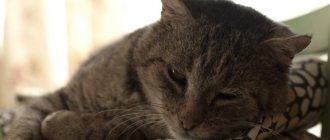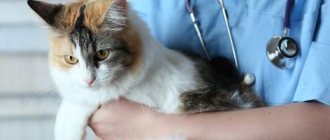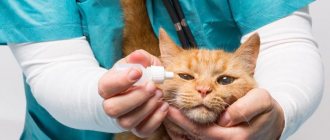(1 votes, rating: 2,00 out of 5)
5589564
08/03/2021 owner reviews
Most cats hate bathing and any activity related to water. Why? Cats are tiny majestic creatures that love to stay clean all the time. Although there are exceptions, most of them don't need baths because they still spend hours upon hours grooming themselves with their tongue.
Even though they can reach most parts of their body with their tongue, there is one part that they cannot reach no matter what - the eyes. And then your furry friend will come to you for help.
Your cat has amazingly beautiful eyes. A little eye discharge is normal for small kittens or even cats, but sometimes their eyes can become runny or watery, forming a crust. If you experience similar symptoms, you should definitely worry.
Learn a few of these tricks to help you keep your cat's majestic eyes clear.
- How to clean cat eyes?
- Causes of discharge from a cat's eye
- Additional Tips
- Finally
How to clean cat eyes?
- Method 1: Warm washcloth
This is more like daily cat eye care at home. All you need is a small soft washcloth and sterilized or boiled water at room temperature. Dip a corner of the cloth into clean water and gently wash away dirt and dust from your cat's eyes and surrounding areas. It is advisable to start from the inner corner of the eye to wipe outwards. Repeat this step carefully to clean your cat's eyes regularly.
© shutterstock
- Method 2: Cotton balls and sterilized water
If you notice that your cat's eyes are dirty and crusty, you can try this method. First of all, wash your hands before and after this procedure. Pour clean water into 2 different bowls (one may be smaller than the other). Dip the cotton balls into the water and gently wipe away the crusty patch from your eyes using a separate cotton ball for a final clean. It is important to use separate cotton balls for two different eyes. One eye may be sick and the other not, so using the same cotton pad on two different eyes will transfer the disease from one eye to the other.
After cleaning, use a dry cotton pad to remove excess water from and around the eyes to prevent water from getting into your eyes. Be careful if the eye condition worsens after cleaning, which may mean your cat's eyes have conjunctivitis.
- Method 3: Using Tea
If you have used tea bags from your evening tea, this is definitely one of the best ways to reuse them instead of wasting them. Surprisingly, the tea has natural antibacterial properties, which is why veterinarians often recommend it to treat cat eye infections.
Place a warm, damp tea bag over the eye that needs more attention. Allow the crust to soften when you can finally wipe off the dirt with a clean cotton swab. Repeat this as long as necessary. If your cat gets anxious when you put a tea bag on her eyes, just give her a good body massage. They're massage suckers!
Diagnostics
The animal must undergo an ophthalmoscopy of the diseased organ.
If a cat has a swollen eye and a bloody trail is observed, the veterinarian finds out the possible cause of the condition, conducts an external examination and prescribes diagnostic procedures, such as:
- ophthalmoscopy;
- radiography;
- measurement of intraocular and blood pressure;
- electroretinogram;
- microscopy;
- fluorescein test;
- Ultrasound of ocular structures.
Causes of discharge from a cat's eye
Eye problems can have devastating consequences. Therefore, as a cat owner, you should be aware that your cat has eye problems. Here are a few reasons why your cat may have eye problems:
- Respiratory infections : A common cause of eye discharge in cats can be infectious respiratory disease, pneumonitis or rhinotracheitis, feline calicivirus (FCV) and protozoa. Early signs of such infections can be very mild or very serious, such as sticky, pus-filled discharge.
- Corneal diseases : A cat's cornea is a dome-shaped surface covering the front of the eye. It can easily become inflamed, injured, or ulcerated. If you see your cat blinking excessively or having excessive tear production, your cat most likely has a corneal disease.
- Conjunctivitis : Note that if there is light pink mucous membrane around your cat's eyes that is swollen, your cat may develop a watery or thick mucous discharge from the eyes. This is not a very common sign, but conjunctivitis with fever, diarrhea and breathing problems can be a serious infection in cats.
- Dry eyes : A dry eye condition is a lack of watering in your cat's eyes. It can lead to inflammation of the cornea and red eyes, and if left untreated, it can lead to blindness. Since the eyes do not produce water, a sticky yellow discharge from the eyes may follow.
© shutterstock
Sources of disease
An infected person, an asymptomatic carrier of the disease, water or food can be a source of intestinal infections. Infection with a viral infection occurs through contact with another person, consumption of contaminated products, or use of shared hygiene products.
Many bacterial and viral intestinal infections are transmitted through dirty dishes, toys, household items and even a smartphone. At the same time, the causative agents of the disease are quite resistant to environmental factors - they can live on fruits and vegetables for weeks, and in water for months. Their favorite habitat is dairy, meat and fish products.
A pathogen such as Giardia cysts can live quietly in a humid external environment for up to 2 months or more. In this case, infection is possible by drinking unboiled water; contact with the carrier is not necessary.
Additional Tips
Once you've adopted a kitten or cat, get them used to the process so they don't find it weird when you do it regularly. If your cat has long hair, try trimming it around the eyes. Little do you know, their corneas can be scratched by their own hair!
Besides, your cat is the most unpredictable, impulsive creature. It's always best to keep an eye on them. If you'll be gone for long hours, make sure there's at least someone to keep an eye on them. Always have someone help you when cleaning your cat's eyes, as they move around a lot and won't want to cooperate with you in this process.
If the crusty, mud-like appearance continues to appear no matter how many times you clean it a day, they will need professional medical attention. Also, if you see that your cat has trouble opening its eyes or there is swelling after you have cleaned the eyes, immediately take him to the nearest veterinarian for further examination.
Prevention
By nature, a cat is capable of independently caring for itself and its health. If your pet leads a clean lifestyle, and his eyes begin to become inflamed, then the source of the infection is in your home. The exception is when the animal has free access to the street.
In any case, if there are animals in the house, frequent and thorough cleaning is necessary to avoid introducing infection into the body of your pets.
If for some reason the cat is not able to clean its eyes and face on its own, then this concern falls on your shoulders. Veterinary stores sell special lotions to clean the eyes of animals. They need to be used daily.
A real owner takes great care of his pets. He takes them to all the necessary vaccinations, prevents various diseases and monitors the cleanliness of the house.
Follow our advice, and your pets will have excellent health!
This article has been checked and approved by a veterinarian. Knyazeva Anna Vladimirovna, veterinarian in private practice, Moscow. more about the expert.
(you can vote for the article)
Tags: cat discharge, cat health, cat
- Related Posts
- What to do if your cat has a stuffy nose?
- TOP 7 vitamins for pregnant and lactating cats
- What to feed a British kitten?
Cat diseases part 2
Cystitis is an inflammation of the bladder mucosa caused by various reasons (inflammation of nearby organs - kidneys, uterus, etc.; injuries, irritants, etc.). The cat urinates with difficulty and often, possibly with blood, the temperature rises, and the bladder area is painful. While waiting for the veterinarian, you can give a drug with a general antiseptic effect - methenamine. You need to follow a diet - exclude meat for a while, replacing it with vegetable broth, switch to dairy foods.
Nephritis - can develop with plague, bronchopneumonia, or as a result of injury. The animal is depressed and has no appetite. Vomiting, difficulty moving the hind limbs. Urination is frequent and copious, often bloody urine, rapid breathing. Call a doctor immediately! Keep your cat warm and give her tea. Treatment should be started as soon as possible, as uremia may develop.
Bladder stones are common in cats, especially older ones. Urolithiasis manifests itself in difficult and painful urination. Treatment by a veterinarian is necessary, since an overfilled bladder can burst, and in general this is a serious metabolic disorder. A strict diet is required depending on the composition of the stones.
Eye diseases
Such diseases should be treated by a specialist. Depending on the diagnosis, he prescribes the necessary eye medications. It is very dangerous to show independence in treatment, since incorrect actions can cause a deterioration in the animal’s condition. The most common eye diseases are watery eyes (epiphora), conjunctivitis, eye damage, foreign body in the eye, third eyelid prolapse.
Lacrimation (epiphora).
Epiphora refers to lacrimation that goes beyond normal limits. Tears are a response to irritation. The causes of lacrimation can be: allergies, inflammation of the connective membrane of the eyes, conjunctivitis, damage to the cornea, blockage of the tear ducts. In addition, lacrimation can be a symptom accompanying mild infectious diseases, such as those of the upper respiratory tract.
Sometimes watery eyes cause a change in the color of the fur under the eyes, so the hair in these areas must be thoroughly washed, and in some cases even shaved.
Conjunctivitis is an inflammation of the cornea of the eye. It can occur as an independent disease, but can accompany infectious diseases. The first sign of inflammation of the cornea is lacrimation. In mild cases, conjunctivitis may go away on its own within 3-7 days, and in others, tear secretions become sticky, yellowish, and accumulate in large quantities in the corners of the eyes, then treatment is necessary.
In order to cure a cat of conjunctivitis, it is first necessary to eliminate the cause that caused it.
In a healthy cat, discharge from the eyes should be clear and watery; in a cat with conjunctivitis, it is usually sticky and opaque. If conjunctivitis does not go away within three days, you should consult a doctor. He will prescribe antibiotics, eye drops, and explain how to wash the eyes.
Damage to the eye, foreign body in the eye.
Severe watering and inflammation of the cornea may be signs that a foreign body has entered the eye or that the eye is damaged.
If lacrimation and inflammation of the cornea are accompanied by pain when blinking or washing with a paw, there is every reason to assume that the eye is damaged or a foreign body has entered it.
An eye examination to determine the causes of lacrimation must be carried out in bright light. To remove a foreign body, place the thumb of one hand on the edge of the lower eyelid and the thumb of the other hand on the edge of the upper eyelid. By pulling back the eyelids, you can examine the eyeball.
Compare the damaged eye with the healthy one. In a healthy eye, the upper surface of the cornea should be smooth and completely transparent.
If you find, for example, a speck or grain of sand in your cat's eye, carefully remove it with a damp gauze swab, moving it along the inner surface of the eyelid to the corner of the eye. If the foreign body is large, it can be removed with tweezers or even your fingertips.
If you are unable to remove the foreign body yourself, you should immediately consult a doctor.
Prolapse of the third eyelid.
The third eyelid (blinking eyelid) quite often falls out of its normal state at the inner corner of the eye and forms folds, sometimes covering part of the eye. Very often this is a sign of local irritation of the eye, for example, when a foreign body enters the eye or when the cornea is damaged.
Sometimes this happens in both eyes at the same time and lasts quite a long time - from several hours to several days. The cause of third eyelid prolapse may be a disorder of the gastrointestinal tract; other signs are loss of appetite, loose stools, vomiting.
After normal activity of the stomach and intestines is restored, the third eyelid returns to its normal position.
For more serious symptoms (high temperature, weight loss, complete lack of appetite), you should immediately consult a doctor.
Prolapse of the third eyelid can sometimes occur in a healthy cat. It usually goes away without treatment. Observe the cat for 1-2 days. If it does not go away within this time, you should consult a doctor, as this may indicate the onset of some disease and lead to undesirable consequences.
Ear diseases
Ear diseases in cats are quite common. The ear is a complex and delicate instrument that must be handled with great care. Ulcers may occur in the ears, the cat may develop ear scabies, otitis externa and otitis media, swelling in the ears may occur due to abscesses and hematomas, and foreign objects may enter the ear.
Ulcers.
When an ulcer occurs in the ear, a foul-smelling, thick discharge appears that dries, forming scabs at the entrance of the auricle. The cat scratches its ear with its paw and shakes its head. A more thorough examination of the ear will reveal significant ulceration.
Do not treat it yourself - take your cat to a veterinarian.
Ear scabies.
It is caused by very small reddish-brown mites, which cause great concern to the animal. The first symptom is ear twitching or violent head shaking. Later, the animal begins to intensively scratch its ear.
As first aid, you can use warm vegetable or olive oil (3-4 drops), which will soften the scab and make the animal feel better. More details
Otitis is an inflammatory process in the ear. A distinction is made between external otitis, which is inflammation of the part of the ear located outside the eardrum, and medial, which is inflammation of the middle ear.
The reasons that cause otitis in a cat can be different, but most often it is an ear mite or a foreign body that has entered the ear.
A cat with otitis media usually shakes its head and scratches its ears with its paws. Sometimes with this disease she holds her head a little to one side, since any change in the position of her head causes her pain.
With otitis media, discharge from the ears may also be observed, in severe cases even purulent. The inner side of the auricle of the affected ear is bright pink or red, swelling may be clearly visible, and an odor appears from the ears.
Otitis requires immediate and vigorous treatment, as it easily becomes chronic and can lead to irreversible changes in the hearing organs.
When treating otitis at home, use 70% isopropyl alcohol or medical alcohol, which is used to clean the ears 2 times a day. After cleaning, 1-2 drops of alcohol can be dropped into the ear and massaged at the base of the cat’s ears in order to enhance the effect of the medicine.
If there is no improvement after 3 days, you should consult a doctor. More details
Swelling on the ears occurs in cats in most cases due to abscesses. Abscesses are called abscesses, ulcers, accumulations of pus in organs or tissues as a result of the inflammatory process. Less commonly, swelling can occur due to a bloody blister that forms between the layers of the ear - a hematoma. The cat may develop severe scratching and even cysts; the animal, trying to get rid of the itching, constantly shakes its head.
If the cat does not have a fever or discharge from the swollen part of the tissue, then without the help of a doctor you will not be able to distinguish an abscess from a hematoma. For a hematoma, it is recommended to use cold lotions. Then you must immediately consult a doctor, otherwise the hematoma can lead to ear deformation.
The hematoma is often removed surgically or a special ointment prescribed by a doctor is applied, which has to be used for quite a long time, sometimes several weeks.
Foreign objects in the ear, such as plant particles or awns of grasses and spikelets, can lead to intense irritation. And if thorns get into the ear, the problem may worsen. All you need to solve it is good lighting, your calmness and a keen eye.
Diseases of the nose
These diseases are quite rare in cats. Most often they accompany other diseases. Nevertheless, any owner needs to know about them.
Sticky, watery, milky-white to yellowish discharge from the nostrils, sneezing, as a rule, are signs of some kind of infectious disease or disease of the upper respiratory tract.
Oral diseases
These diseases are often accompanied by difficulty eating, drooling, difficulty swallowing and bad breath. The origin of these diseases is different. These are inflammations, foreign bodies, tartar.
Inflammation.
Most often there is inflammation of the edges of the lips, gums, oral mucosa (including the tongue), tonsils and pharyngeal cavity. These diseases must be treated by a veterinarian who will determine whether they are infectious or not.
Inflammation of the gums (gingivitis).
Red, bloodshot gums can be a sign of gingivitis.
Only a specialist can make an accurate diagnosis. Since it is very difficult to carry out treatment at home, in such cases it is necessary to seek the help of a doctor.
Some cats are prone to this disease.
Foreign body in the mouth.
Cats that have a foreign body in their mouth try to get rid of it with the help of their paws, lips and tongue. The cat rubs its front paws around its mouth and works hard with its tongue. Often the mouth is not completely closed - it may also be a sign that the cat has a loose tooth (a common phenomenon, especially in old animals).
If your cat has something stuck in her mouth, calm her down and examine her mouth, tongue, and roof of her mouth under a bright light.
Most often, chicken bones, skins, threads, and even needles and pins get stuck in the mouth. If you find a foreign body in your cat's mouth, use your fingertips or tweezers to remove it. If you are unable to find an object in your mouth or cannot remove it, consult a doctor without wasting time. Anesthesia is sometimes used to remove a foreign body.
Tartar is a hard white or yellow or gray substrate, that is, deposits of various mineral substances, covering a cat's teeth. Tartar usually occurs in older animals.
They can cause inflammation and an unpleasant odor. The stones must be removed by a veterinarian.
Functional disorders and diseases of the nervous system
Cats are very vulnerable and easily excitable animals. Therefore, you need to take special care of your pet’s nervous system. This attention should be strengthened during puberty and during the animal’s adaptation after illness. The most common diseases and dysfunctions of the nervous system are hysteria, nervous crisis, convulsions and fits, and meningitis.
Hysteria in cats, as in people, is more common in females. It appears mainly during puberty. Heredity plays a certain role in the development of the disease. Nervous crises of unknown origin are noted. The animal either hides or bites everything and everyone indiscriminately. The crisis does not last long, followed by a period of depression and lethargy. It is very important, as with other symptoms of damage to the nervous system, to immediately consult a doctor. If there is nothing serious, we are simply dealing with a hysterical woman. In such cases, the cat is advised to be neutered and given sedatives.
Nervous crisis.
The animal is overexcited: the cat rushes from side to side, its movements are erratic. She seems to be looking for someone to bite or scratch, but does not recognize the owners. All this can end in convulsions and falling to the floor.
This condition can be caused by a number of reasons. These are plague, worms, ear diseases (itching from ear mites or pain from ear inflammation). It is necessary to immediately contact a veterinarian. All signs indicate that the situation is serious. While waiting for the doctor, place the cat in a quiet, fairly dark place, isolate it, and leave it alone.
Seizures in cats are extremely rare. A sick animal may experience anxiety, fuss, become angry, run into things and objects, and lose coordination. Sometimes there are muscle spasms, convulsive muscle twitching, and foam appears on the mouth. In these cases, you should immediately contact your veterinarian.
Seizures are just a symptom of a more complex disease, the causes of which lie deeper. The veterinarian will try to find out what is causing them. All that is required of you is to protect the animal from injury. Keep your cat in a confined space and do not touch her until the seizure ends and she calms down. After that, call a specialist.
Epilepsy.
These are convulsive seizures, accompanied by loss of consciousness and general sensitivity. An epileptic seizure is a painful condition that suddenly takes over a cat for a while, then releases, only to start again unexpectedly. During a seizure, a cat becomes completely helpless.
A seizure is usually preceded by a change in the cat's behavior: she is either excited and overly intrusive, or, conversely, depressed and indifferent to everything.
An epileptic seizure in a cat is an extremely sad and scary picture. It usually lasts only a few minutes ( 1-5 ), which seems like an eternity. Consciousness is confused, the cat does not hear, does not respond to its name, does not orient itself, does not see the people and objects around it.
Seizures can be large, with loss of consciousness, or small. They may be accompanied by salivation, urination, and bowel movements.
There are many reasons that can cause an epileptic seizure in a cat: consequences of brain injury, complications after an infectious disease, vitamin deficiencies, lack of mineral salts in food, poisoning, intoxication, the presence of parasites in the ear or intestines, prolonged overstrain of the nervous system.
You should not be afraid of a cat in a seizure state. During convulsive manifestations, the cat's twitching head must be supported, but so that the cat does not bite, or a soft bedding must be placed under it, that is, to prevent the possibility of traumatic injury. Treatment by a veterinarian is required.
Meningitis is an inflammation of the meninges. Caused by injuries, and also occurs as a complication of plague. In the first stages, the animal is restless, irritable, and has no appetite; the cat is vomiting, there are convulsions, signs of paralysis of the limbs. The pupil is contracted.
Place the cat in a dark, quiet place until the doctor arrives, you can put a cold compress on the head, and support the heart with coffee or strong tea.
Flu.
This condition is also known as pneumonitis, but do not confuse it with pneumonia. Abyssinian, Burmese and Siamese cats are most susceptible to cat flu. Fortunately, there is now an effective vaccine against it. This disease is not transmitted to dogs or people.
Among the first noticeable symptoms are sneezing and slight discharge from the nose and respiratory tract. The temperature rises to 40° C. This is followed by profuse salivation and apathy, followed by significant watery discharge from the eyes and nose. After one or several days, the discharge thickens and turns yellow, and the eyelids become swollen and puffy. As the disease progresses, ulcers may appear in the mouth, vomiting and dehydration may begin.
Consult your doctor, but do not take your cat to him without first making an appointment. The doctor may decide to visit you at home to avoid the risk of infecting other patients.
Feline leukemia is a viral disease. The virus in the cat's body appears and multiplies mainly in the bone marrow cells, where red blood cells arise. He attacks them, but does not kill them. The attacked blood cells become weakened, which leads to a significantly weakened cat's immunity against other diseases. Feline leukemia in itself is not destructive, it only prepares the conditions for other viruses. After suffering a serious infection with the leukemia virus, most cats even become immune to further infections.
A cat becomes infected through contact with an already infected cat, its urine, saliva or milk, or contact with its bowls and bed. The virus can be transferred by the placenta to unborn kittens. The incubation period lasts up to one year. The number of infected cats kept at home is insignificant, while in places where cats gather in large numbers, the infection rate of the virus is higher.
The insidiousness of this disease lies in the fact that we do not yet know the extent of its prevalence, since we do not have the opportunity to find out the number of domestic cats. Leukemia has no specific symptoms, and deaths are usually attributed to some other cause.
Feline leukemia has nothing in common with human leukemia, so mutual infection is excluded.
Cancer.
Cancer is the excessive formation of new tissue. The reasons for its occurrence are still unknown. These neoplasms (tumors) in cats appear in two forms. Benign tumors are usually characterized by slow growth and are usually located in one place, from where they can be surgically removed. Malignant, actually cancerous, tumors are characterized by rapid growth caused by the destruction of nearby tissues. Metastases usually develop in them, and even with the help of surgery it is not possible to save the body.
Tumors in cats most often appear in the liver, spleen, kidneys and, especially, in the stomach and mammary glands. Most cases occur between 4-8 years. Symptoms of cancer are not fully defined: periodic lack of appetite and low fever, diarrhea in some animals, constipation in others; Over time, the disorders disappear on their own, but then reappear. The most humane thing would be to operate on a cat if cancer is established, and if the hope for recovery is minimal, then not allow it to wake up after anesthesia.
AIDS, or immune deficiency syndrome, is called the plague of the 20th century. Panic over the incredibly rapid spread of this terrible deadly disease has not spared cats.
Feline immunodeficiency virus (FIV) is a lymphotropic lentivirus that causes acquired immunodeficiency syndrome in domestic cats. The immune and nervous systems are affected. The disease is characterized by slow, gradual development, polymorphism of clinical manifestations.
virus was first isolated in 1987 from a group of cats in the United States. Then the virus was discovered in Switzerland and other European countries (Great Britain, France, Holland). Today, the infection has become endemic in cats all over the world. Back to the top of the article










